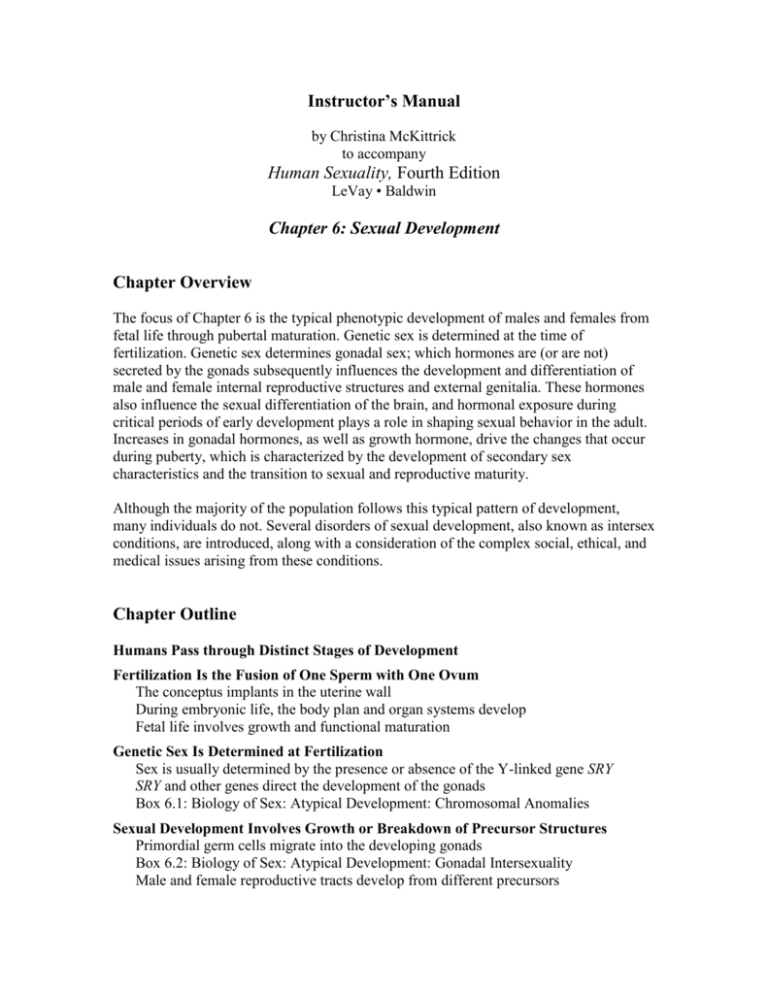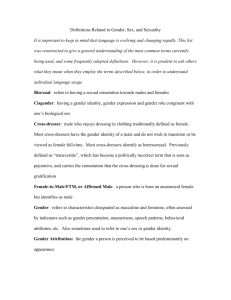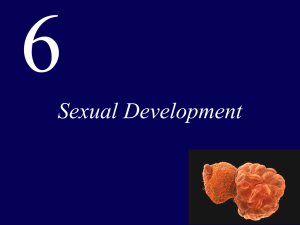Human Sexuality, 4e - Sinauer Associates
advertisement

Instructor’s Manual by Christina McKittrick to accompany Human Sexuality, Fourth Edition LeVay • Baldwin Chapter 6: Sexual Development Chapter Overview The focus of Chapter 6 is the typical phenotypic development of males and females from fetal life through pubertal maturation. Genetic sex is determined at the time of fertilization. Genetic sex determines gonadal sex; which hormones are (or are not) secreted by the gonads subsequently influences the development and differentiation of male and female internal reproductive structures and external genitalia. These hormones also influence the sexual differentiation of the brain, and hormonal exposure during critical periods of early development plays a role in shaping sexual behavior in the adult. Increases in gonadal hormones, as well as growth hormone, drive the changes that occur during puberty, which is characterized by the development of secondary sex characteristics and the transition to sexual and reproductive maturity. Although the majority of the population follows this typical pattern of development, many individuals do not. Several disorders of sexual development, also known as intersex conditions, are introduced, along with a consideration of the complex social, ethical, and medical issues arising from these conditions. Chapter Outline Humans Pass through Distinct Stages of Development Fertilization Is the Fusion of One Sperm with One Ovum The conceptus implants in the uterine wall During embryonic life, the body plan and organ systems develop Fetal life involves growth and functional maturation Genetic Sex Is Determined at Fertilization Sex is usually determined by the presence or absence of the Y-linked gene SRY SRY and other genes direct the development of the gonads Box 6.1: Biology of Sex: Atypical Development: Chromosomal Anomalies Sexual Development Involves Growth or Breakdown of Precursor Structures Primordial germ cells migrate into the developing gonads Box 6.2: Biology of Sex: Atypical Development: Gonadal Intersexuality Male and female reproductive tracts develop from different precursors Box 6.3: Biology of Sex: Atypical Development: Androgen Insensitivity Syndrome Male and female external genitalia develop from the same precursors Box 6.4: Biology of Sex: Atypical Development: Congenital Adrenal Hyperplasia The gonads descend during development Box 6.5: Biology of Sex: Atypical Development: 5-Reductase Deficiency Box 6.6: Biology of Sex: Atypical Development: Hypospadias and Micropenis Hormones Influence the Sexual Differentiation of the Central Nervous System The CNS contains sexually dimorphic structures Sexual dimorphism arises as a consequence of differing hormonal levels during a sensitive period Early Hormonal Exposure Influences Later Sexual Behavior Experiments on rodents show activational and organizational effects of androgens Primates have multiple sensitive periods Other Y-Linked Genes Besides SRY Influence Development External Factors Influence Prenatal Sexual Development Biological and social factors interact postnatally Puberty Marks Sexual Maturation The pubertal growth spurt occurs earlier in girls than in boys Puberty is marked by visible and invisible changes in the body What drives puberty? The body may signal its readiness for puberty to the brain Box 6.7: Biology of Sex: Atypical Development: Precocious and Delayed Puberty Dietary changes may be the reason puberty is beginning earlier Sex hormones may have organizational effects at puberty Intersexuality Raises Complex Social and Ethical Issues Box 6.8: Personal Points of View: My Life with Androgen Insensitivity Syndrome Chapter Summary 1. A fertilized ovum immediately begins a series of cell divisions, becoming a conceptus. At the blastocyst stage, when the conceptus has developed a central cavity, it implants in the wall of the uterus and secretes human chorionic gonadotropin, which prevents regression of the maternal corpus luteum. Pregnancy is established at this point. After forming the extraembryonic membranes, the remaining tissue of the conceptus gives rise to the embryo. 2. By about 6 weeks after conception the embryo has developed its body plan and most of its major organs and is known as a fetus. Further fetal development involves growth and the gradual onset of function in the various organ systems. 3. Sex is usually determined by the sex chromosomes: The XX pattern causes female development, and the XY pattern causes male development. The key player in male development is the gene SRY, on the Y chromosome, which induces the embryo’s genital ridges to become testes. In female embryos, which lack SRY, other genes direct the genital ridges to become ovaries. Anomalous sex chromosome patterns include XXY, which causes Klinefelter syndrome, and XO, which causes Turner syndrome. 4. The male and female internal reproductive tracts develop from different precursors— the Wolffian and Müllerian ducts. In XY embryos (normal males), the testes secrete antiMüllerian hormone (AMH), which causes the Müllerian ducts to regress, and androgens, which cause the Wolffian ducts to develop further and produce the male internal anatomy. In XY embryos lacking functional androgen receptors (androgen insensitivity syndrome [AIS]), neither the male nor the female reproductive tract develops. In XX embryos (normal females), the lack of AMH allows the Müllerian ducts to develop further, and the lack of androgens allows the Wolffian ducts to regress, producing the female internal anatomy. 5. The external genitalia of the two sexes develop from common precursors. The urethral folds give rise to the labia minora in females and to the shaft of the penis in males. The genital swellings give rise to the labia majora in females and the scrotum in males. The genital tubercle forms the external portion of the clitoris in females and the glans of the penis in males. Male-typical development of the external genitalia requires the presence of testosterone and its conversion to 5-dihydrotestosterone (DHT). In genetically female fetuses that are exposed to high levels of androgens (as in congenital adrenal hyperplasia [CAH]), and in genetically male fetuses that lack androgen receptors (androgen insensitivity syndrome) or that cannot convert testosterone to DHT (5-reductase deficiency), the external genitalia will be sex-atypical to a variable degree. 6. Both ovaries and testes descend from their original lumbar position during fetal life. The ovaries descend into the pelvis, on either side of the uterus. The testes descend into the pelvis and then through the developing inguinal canal into the scrotum. If the testes fail to descend by 3 months after birth, spermatogenesis may be impaired. 7. Exposure to sex hormones during fetal life is directly or indirectly responsible for the sexual differentiation of the central nervous system. These hormones cause the development of sexually dimorphic structures and circuits and, by doing so (at least in experimental animals), influence the kinds of sexual behaviors that are exhibited in adulthood. The effects of hormones on behavior are thought to occur in two main phases: organizational effects during prenatal brain development and activational (triggering) effects in adulthood. 8. External factors also influence prenatal sexual development. These factors may include drugs such as synthetic sex hormones. After birth, social factors further influence the development of the brain and adult sexual behavior, to judge from experimental studies in nonhuman primates. 9. Puberty is the biological transition from childhood to sexual maturity. It is marked by further development of the reproductive tracts and external genitalia, the appearance of secondary sexual characteristics (e.g., breasts or facial hair), signs of functional sexual maturity (i.e., onset of menstruation or ejaculation), and a growth spurt followed by cessation of growth. In the United States, puberty begins earlier in girls than in boys, and earlier in African-American girls than in white American girls. Precocious puberty (defined as puberty beginning before age 7 in girls or age 9 in boys) and delayed puberty can usually be treated medically, if necessary. 10. Puberty is caused by a rise in the circulating levels of adrenal and gonadal sex steroids and growth hormone. Gonadal secretion is triggered by a rise in pituitary gonadotropins, which, in turn, is triggered by the onset of secretion of gonadotropinreleasing hormone (GnRH) from the hypothalamus. It is thought that the prime trigger for puberty is the attainment of a critical body weight, weight-to-height ratio, or body fat index. The body may communicate this information to the hypothalamus by means of the hormone leptin. 11. In Western countries, puberty has been starting at progressively younger ages over the last 150 years. The most likely reason is a progressive change in nutritional practices, which have led to more rapid weight gain during childhood. Lecture Notes (Bulleted items are grouped as suggested slides for presentation purposes.) Fertilization Is the Fusion of One Sperm with One Ovum Fertilization, or conception, occurs when a single sperm enters a single ovum to produce a zygote (Figure 6.3) Prior to fertilization, sperm must undergo capacitation and the acrosome reaction After the sperm fuses with the plasma membrane, a chemical reaction blocks the entry of other sperm, and the ovum completes its second meiotic division A conceptus is the entire collection of cells derived from the fertilized ovum from the 2-cell stage onward (Figure 6.4) By the 32-cell stage, the conceptus is called a blastocyst—it develops a fluidfilled cavity and implants itself in the wall of the uterus (Figure 6.5) o The inner cell mass becomes the embryo and the outer layer of cells forms part of the placenta Around 6 days after fertilization, the blastocyst secretes the hormone human chorionic gonadotropin (hCG), which signals mother’s body that implantation has occurred During Embryonic Life the Body Plan and Organ Systems Develop By 2 weeks after fertilization, the embryo consists of three layers of cells: ectoderm, mesoderm, and endoderm During the embryonic phase of (2–6 weeks postconception) all major organ systems have begun to develop After this point, the embryo is referred to as a fetus; subsequent fetal development involves growth and the functional maturation of body systems (Figure 6.6) Genetic Sex Is Determined at Fertilization Our understanding of sex differentiation is based upon studies with rabbits conducted by the French embryologist Alfred Jost (Figure 6.7) Six-week-old embryos possess undifferentiated structures called “genital ridges” that will develop into either testes or ovaries o Male development depends upon the presence of the SRY gene, which causes the fetus to develop testes, which secrete testosterone and anti-Müllerian hormone (AMH) (Figure 6.8) o Female development (with the exception of ovaries) proceeds in the absence of specific genetic instructions, although several genes are involved in both stimulating ovarian development and inhibiting testis development (Figure 6.9) Sexual Development Involves Growth or Breakdown of Precursor Structures At 6 weeks postconception, both male and female embryos possess two sets of ducts that run from each gonad to the future site of the external genitalia (Figure 6.11) o In male fetuses, testosterone stimulates the Wolffian ducts to develop into the epididymis, vas deferens, ejaculatory ducts, and seminal vesicles, and AMH causes the Müllerian to regress and disappear o In female fetuses, in the absence of AMH, the Müllerian ducts develop into the oviducts, uterus, and the deeper part of the vagina, while the Wolffian ducts regress and disappear in the absence of testosterone At this time, the external genitals of male and female embryos are identical and consist of the genital tubercle (forms glans of penis or clitoris), urethral folds (forms shaft of penis or labia minora), and urethral swellings (forms scrotum or labia majora) (Figure 6.12) o In male fetuses, testosterone must be converted to 5-dihydrotestosterone (DHT) for masculinization of the external genitalia to occur o In female fetuses, feminization of genitals occurs in the absence of hormonal signals Several Types of Atypical Sex Development Exist in Humans Chromosomal anomalies can occur when there are fewer or more than two sex chromosomes (Box 6.1) o Turner syndrome (XO) individuals are phenotypic females who do not enter puberty and are infertile o Klinefelter syndrome (XXY) individuals are phenotypic males who are generally tall with somewhat feminized secondary sex characteristics and low testosterone levels Gonadal intersexuals, historically called true hermaphrodites, possess both ovarian and testicular tissue (Box 6.2) In androgen insensitivity syndrome (AIS), genetic males who are unresponsive to androgens (Box 6.3) develop as phenotypic females but with no internal reproductive structures Congenital adrenal hyperplasia (CAH) leads to increased androgen production by the adrenal gland (Box 6.4) o Genetic females with CAH may have masculinized genitals (e.g., elongated clitoris, fused labia) Individuals with 5-reductase deficiency cannot convert testosterone to DHT (Box 6.5) o Genetic males have genitals that are not fully masculinized at birth Males with hypospadias or a micropenis have a misplaced urethral opening or small penis, respectively (Box 6.6) Hormones Influence Sexual Differentiation of the Central Nervous System The CNS contains sexually dimorphic structures and cell groups: o Onuf’s nucleus innervates motor neurons of the pelvic floor, including the base of the penis It is larger and contains more neurons in men than in women o Medial preoptic area of the anterior hypothalamus (Figure 6.14) is associated with male sexual behavior in rodents o Within this region in humans, the third interstitial nucleus of the anterior hypothalamus (INAH3) is larger in males than in females Numerous structural, functional, and chemical differences have been identified throughout the brains of men and women, although the significance of these differences is unclear These differences may arise as a consequence of hormone action during sensitive periods of development Early Hormonal Exposure Influences Later Sexual Behavior Experiments in rodents reveal both organizational and activational actions of hormones (Figure 6.17) o Organizational effects of hormones can affect brain circuitry and generally occur during sensitive periods of development o Activational effects occur when the presence of a hormone leads has a direct effect on a behavior or response Primates exhibit multiple sensitive periods during which hormonal effects can impact subsequent behavior Other Y-Linked Genes besides SRY Influence Development Several Y-linked genes are necessary for normal spermatogenesis There is a gene on the Y chromosome that increases stature In mice, some brain and behavioral differences are influenced by genetic mechanisms not involving SRY and testicular hormones External Factors Influence Prenatal Sexual Development Environmental factors such as maternal stress or exposure to hormones and related chemicals and drugs can affect sexual development Prenatal hormone exposure creates a predisposition that can be modified by social and environmental circumstances, leading to differences in sexual behavior and brain anatomy Puberty Marks Sexual Maturation Puberty is the biological transition to sexual maturity Pubertal growth spurts both begin and end earlier in girls than in boys, leading to an increase in height as well as changes in skeletal structure and body composition (Figure 6.19) Puberty is initiated by the pulsatile secretion of GnRH, which stimulates gonadotropin and gonadal hormone secretion (Figure 6.24) Body weight or the accumulation of a critical amount of body fat may use hormonal signals to trigger the hypothalamus to initiate pubertal maturation In girls, changes during puberty include breast development (Figure 6.21), growth of axillary (armpit) and pubic hair, and growth and maturation of the internal reproductive tract and external genitalia o The onset of menstruation, or menarche, is a dramatic event in female pubertal development and has been starting at progressively younger ages in Western countries (Figure 6.22) In boys, growth of the penis and growth of pubic, body, and axillary hair, as well as deepening of the voice usually follow enlargement of the testes (Figure 6.23) o Ejaculation may occur following masturbation or during sleep (nocturnal emissions) Intersexuality Raises Complex Social and Ethical Issues Intersex conditions may affect an individual’s psychological well-being as well as anatomy and sexual function The Accord Alliance is an organization devoted to promoting the medical and psychological health of people with intersexed conditions, in part by increasing social awareness, understanding, and acceptance of people with these conditions Class Discussion Questions 1. Define “conceptus” and “pregnancy.” Are the different definitions of these terms relevant to ethical debates concerning the use of embryonic stem cells for research purposes? 2. Alfred Jost claimed that females represented the “default sex.” Do you agree with this statement regarding fetal development of the internal reproductive structures and external genitalia? What about fetal development of the gonads? 3. Describe the difference between organizational and activational effects of hormones on behavior. 4. Discuss the role of biological and environmental factors in shaping sexual behavior. 5. Discuss the ethical issues surrounding surgical “correction” of ambiguous genitalia. 6. What are some of the potential advantages and disadvantages of studying sex differences in brain anatomy, chemistry, and function? Teaching Suggestions/Resources 1. Kessler, S. J. (1990). Lessons from the Intersexed. Rutgers University Press. 2. Dreger, A. D. (1998). Hermaphrodites and the Medical Invention of Sex. Harvard University Press. 3. Migeon, C. J., & Wisniewski, A. B. (2000). Human sex differentiation: From transcription factors to gender. Hormone Research, 53, 111–119. 4. Lee, P. A. Houk, C.P. Houk, Ahmed, S.F., Hughes, I.A. in collaboration with participants in the International Consensus Conference on Intersex (2006). Consensus Statement on Management of Intersex Disorders. Pediatrics, 118, e488–e500. 5. Howard Hughes Medical Institute (2001) Holiday Lecture on the Meaning of Sex: Genes and Gender http://www.hhmi.org/biointeractive/gender/lectures.html Recommended Reading Bertelloni, S. & Hiort, O. (Eds.). (2010). New concepts for disorders of sex development. Karger. Eugenides, J. (2002). Middlesex. Farrar, Straus and Giroux. (Pulitzer Prize–winning novel about a person with 5-reductase deficiency.) Larsen, W. J. (1998). Essentials of human embryology. Churchill Livingstone. Migeon, C. J. & Wisniewski, A. B. (2003). Human sex differentiation and its abnormalities. Best Practice & Research Clinical Obstetrics and Gynaecology, 17, 1– 18. Pfaff, D. W. (2010). Man and woman: An inside story. Oxford University Press. Pinsky, L., Erickson, R. P. & Schimke, R. N. (1999). Genetic disorders of human sexual development. Oxford University Press.






